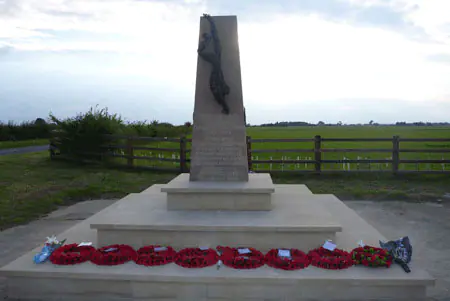
Flying Officer Roy Yule DFC – a Lancaster pilot and captain on No 626 Squadron based at RAF Wickenby, Lincs during 1945.
‘On February 7th 1945 we were briefed for a night raid on Kleve. This operation was to prepare the way for the attack by 15th Scottish Division across the German frontier near Reischwald. We took off at 7pm and at 10pm approached the target at 10,000 feet. There was a layer of thin cloud at 5,000 feet and we clearly heard the Master Bomber, who was circling in a Mosquito at 3,000 feet, ordering the main force to come below cloud. To comply with his orders, I closed the throttles and put the aircraft into a dive, getting under the cloud and levelling off at 4,000 feet. This turned out to be one hell of a dangerous bombing run. Over half the main force did not come below cloud but bombed through it on the fires and flares that could be seen through the thin layer.
The one hundred and forty or so Lancaster pilots that did obey the Master Bomber converged onto the tight bunch of target markers. Stan, the bomb aimer, gave “Bomb-doors open”, and we heard the clear, casual voice of the Master Bomber, “Bomb to starboard of the red Target Indicators”. Then I had to dodge under another Lancaster coming from our port side, looking up into its yawning bomb bay with its rows of 500lb bombs and a cookie. I jabbed the left rudder to slide clear of it. Stan, who could not see the other Lanc, had started his run-up patter giving me “Right,” and shouted agitatedly, “Right, not bloody left!”
The scene ahead was fantastic. Red and yellow tracer shells were crisscrossing from the flak batteries outside the town. They seemed to be coming from eight different positions and looked like 20 mm and 37 mm, which are nasty blighters at the height we were at. Strings of bombs were falling through the cloud from the Lancs above. Flashes from the exploding blockbusters on the ground were blinding. A stricken Lancaster crashed on its run-in blowing up with its full bomb load. Large columns of thick black smoke rose from the town up to 3,000 feet.
Stan gave, “Right, right, steady, bombs away.” then our aircraft was bucking and rearing as the pressure waves hit us. 4,000 feet was reckoned to be the absolute minimum height for dropping a blockbuster. At last we were through the target and turning south over the Rhine and my stomach muscles started to relax.’
We landed back at Wickenby at 42 minutes after midnight. At debriefing, Frank, the mid-upper gunner, said that a string of bombs with a wobbling blockbuster dropped past our starboard tail-plane as our own bombs were leaving.
To find out about Wickenby Museum, please click here.